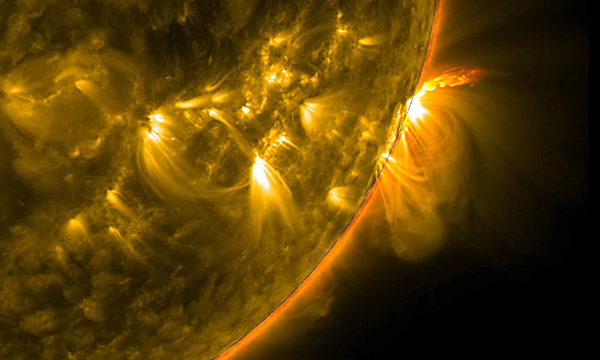For the first time, researchers have coaxed a metal in a liquid state to convert into a state of matter known as a plasma. The results offer new insights into this fourth state of matter, which has its place beside the three commonly known states of gas, liquid, and solid. See also: Gas; Liquid; Matter (physics); Phase transitions; Physics; Plasma (physics)

Although encountered on Earth only in isolated instances, such as in lightning and neon signage, plasma is the most abundant state of matter in the universe, comprising stars as well as the energized material between galaxies. Plasma is normally formed when gas atoms absorb enough energy from radiation for their electrons to break free of the attractive, electromagnetic pull of the atomic nucleus. The atoms thus become charged ions. If the energy (for example, under high-temperature conditions) remains sufficient, these ions and electrons do not link up again as atoms, but instead remain in a charged, fluid-like state. If conditions—again, temperature, but also often pressure—are extreme enough, the positively charged atomic nuclei overcome their electromagnetic repulsion and start to fuse into heavier atoms. This process, known as nuclear fusion, is the power source for stars. See also: Atom; Atomic nucleus; Atomic physics; Electric charge; Electromagnetism; Electron; Energy; Galaxy; Heat; Ion; Lightning; Neon; Nuclear fusion; Radiation; Star; Universe
In a new study, researchers created a plasma in a different way. The researchers initially cooled atoms of deuterium—an isotope of hydrogen—into a dense, liquid state at around 21 K (-252°C or -422°F). Powerful lasers were then beamed into the deuterium, generating shock waves that compressed the ultracold liquid up to five million times Earth's normal atmospheric pressure. The compression increased the liquid’s temperature to more than 100,000 K (approximately 100,000°C or 180,000°F). As pressure and temperature increased, the initially transparent deuterium began to exhibit optical reflectivity, which is a property of metals. The electrons began behaving in a quantum-mechanical manner, sharing particular energy states. Then, as the material reached higher-end temperatures, the reflectivity of the liquid metal deuterium started changing in a manner that indicated that the electrons had actually stopped behaving quantumly. Instead, the electrons and ions began engaging in collisions and movements consistent with a plasma described by the statistics of classical physics, based on principles such as Newton's laws of motion and Einstein's theory of relativity. See also: Atmosphere; Classical field theory; Classical mechanics; Collision (physics); Deuterium; Hydrogen; Isotope; Laser; Metal; Newton's laws of motion; Pressure; Quantum mechanics; Relativity; Shock wave; Temperature
The switchover from quantum to classical physics exhibited by the experimental material did not fully match with long-held, conventional expectations, opening the door to additional experimentation that could refine the physics of plasmas and their associated phase transitions. The study's authors suggest that such research could improve modeling of plasmas in astrophysical objects, such as stars and "failed" stars, called brown stars. Another path forward for further related research leads into continuing human efforts to harness fusion for energy production—a challenge that many scientists hope will finally be met later in the 21st century. See also: Brown dwarf; Electric power generation; Energy sources; Harnessing the power of nuclear fusion in tokamak reactors; Nuclear reaction





